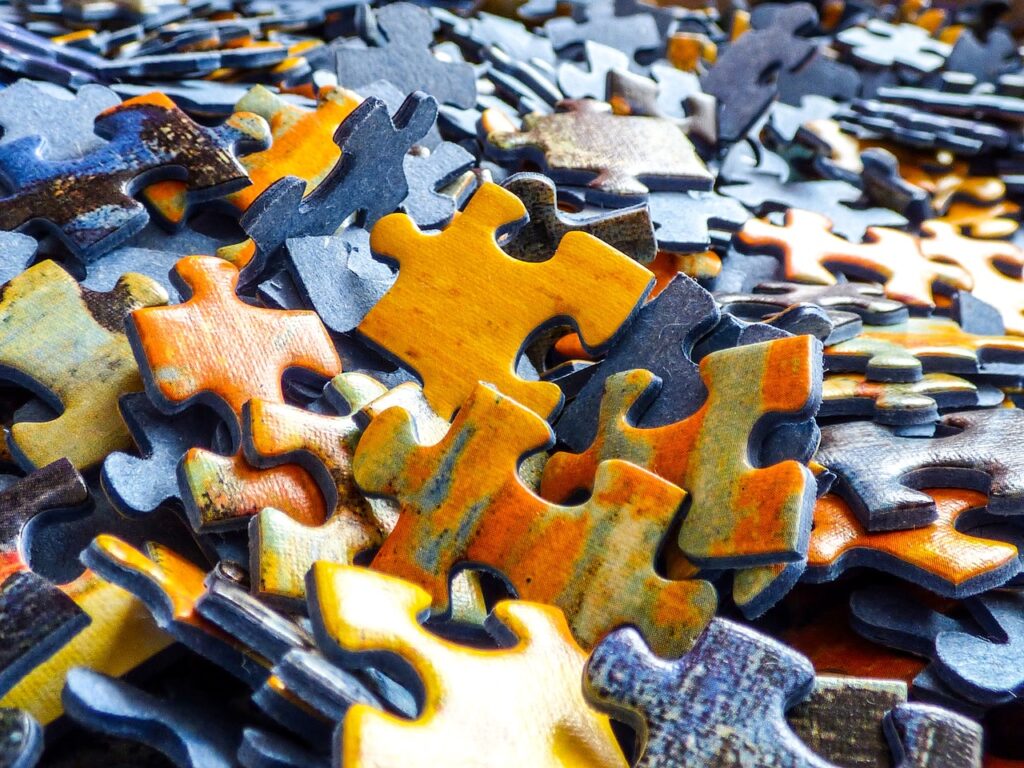Last Updated on February 19, 2024 by JigsawPuzzleGuru
Table of Contents
Unveiling Their Impact on Enhancing Cognitive Abilities
Puzzles, in all their varied forms, have long been a source of entertainment, but they also play a significant role in cognitive development and brain function enhancement. Engaging with puzzles requires a combination of cognitive skills including memory, attention, and problem-solving. The science behind puzzles indicates that the regular practice of solving puzzles creates a positive impact on mental agility and can contribute to maintaining cognitive health over time.

The mental exercise involved in puzzle solving initiates complex cognitive functions. As individuals work through a puzzle, they employ reasoning skills and pattern recognition. These mental processes are vital for decision-making and critical thinking. Puzzles also encourage the brain to operate in a state of flow, which is a deep level of concentration that can improve cognitive abilities and enhance overall mental acuity.
Studies have shown that puzzles can have lasting benefits for the brain, particularly in areas such as memory retention and the speed at which cognitive tasks are performed. For example, crossword puzzles have been associated with a delayed onset of memory decline in older adults, while jigsaw puzzles can help in improving visual-spatial reasoning. Through engaging in these activities, individuals of all ages are not only enjoying the challenge but also nurturing their brain health and protecting against cognitive decline.
Cognitive Benefits of Puzzles
Engaging in puzzles activates numerous cognitive abilities, specifically enhancing problem-solving skills, memory capabilities, and overall mood.
Problem-Solving Skills
Puzzles often present a challenge that requires the solver to employ logic, pattern recognition, and sequence solving to arrive at a solution. They provide a mental workout that improves the brain’s ability to think critically and devise multiple solutions to complex problems. This is crucial for real-world applications, as it translates to better decision-making and strategic planning abilities.
Memory Enhancement
Regular puzzle-solving exercises the hippocampus – the brain’s memory storage center – making it more efficient at storing and recalling information. Research indicates that puzzles can enhance visual-spatial reasoning, helping individuals remember shapes, colors, and positions as well as improve short-term memory.
Mood Improvement
The process of completing a puzzle can be immensely satisfying and can stimulate the release of dopamine, a neurotransmitter associated with feelings of pleasure. This not only uplifts mood but also can decrease stress levels. Furthermore, the sense of accomplishment upon solving a puzzle boosts self-esteem and promotes a positive attitude.
Neuroscience of Puzzles
Engaging in puzzles activates various brain functions, particularly enhancing neuroplasticity and triggering dopamine release.
Neuroplasticity
Neuroplasticity refers to the brain’s ability to reorganize itself by forming new neural connections throughout life. Puzzles pose complex challenges that require the brain to adapt and develop new strategies. When individuals solve puzzles, they stimulate neural pathways involved in problem-solving and cognitive function.
- Puzzle-solving impacts specific brain regions involved with spatial awareness and memory formation.
- These activities contribute to the strengthening of existing connections and the creation of new ones, enhancing cognitive flexibility.
Dopamine Release
The act of solving puzzles leads to the release of dopamine, a neurotransmitter associated with pleasure and reward. This chemical release occurs in the brain’s reward pathways during key moments, such as when a person:
- Identifies a pattern or connection.
- Anticipates the completion of a puzzle.
- Successfully completes the puzzle.
Each successful recognition or placement in a puzzle acts as a reward stimulus, maintaining engagement and motivation. This dopaminergic activity can also improve:
- Mood
- Concentration
- Motivation
Puzzles in Educational Settings

Incorporating puzzles into educational settings can enhance cognitive development and cater to diverse learning preferences. They serve as effective tools for both teachers and students in achieving educational objectives.
Curriculum Integration
Puzzles can be integrated into various aspects of the curriculum to reinforce learning and problem-solving skills. For example:
- Mathematics: Puzzles can exemplify mathematical concepts such as geometry, probability, and logic.
- Language Arts: Crossword puzzles and word searches can expand vocabulary and improve spelling.
- Science: Jigsaw puzzles of cells, human anatomy, or ecosystems can familiarize students with scientific structures and processes.
Incorporating puzzles into lesson plans helps solidify abstract concepts through hands-on experience and can encourage collaborative learning when implemented in group settings.
Learning Styles and Adaptation
Different students have different learning styles, and puzzles are versatile tools that can be adapted to suit various preferences. For instance:
- Visual Learners: Jigsaw and pattern puzzles can help these students understand spatial relationships and visual patterns.
- Kinesthetic Learners: Physical manipulation of puzzle pieces can facilitate learning through movement and touch.
- Logical Learners: Logic puzzles and Sudoku engage students who are adept at reasoning and strategy.
By providing a multifaceted approach to education, puzzles offer multiple entry points for understanding content, allowing for a broader range of students to benefit from curriculum materials.
Challenges and Limitations
While puzzles can provide cognitive benefits, it’s important to recognize the challenges and limitations inherent in their use as brain training tools. These issues are influenced by the variety of puzzle difficulties available and the accessibility of puzzles for all individuals.
Varied Difficulty Levels
The effectiveness of puzzles can depend heavily on the difficulty level relative to the user’s capability. Too simple, and the brain isn’t sufficiently challenged to benefit; too hard, and it could lead to frustration without cognitive gain.
- Optimal Challenge: The level that provides just enough difficulty to stimulate cognitive processes without causing excessive stress.
- Mismatched Complexity: When puzzle difficulty is too far removed from a user’s skill level, diminishing returns in cognitive improvement may occur.
Accessibility Considerations
Accessibility to puzzles can be limited for certain populations, which may reduce the diversity and inclusivity of these brain-enhancing tools.
- Physical Limitations: Some individuals may have motor impairments that make traditional puzzles unwieldy or impossible to engage with.
- Sensory Challenges: Visual or hearing impairments can also restrict access to many puzzle types.
- Economic Barriers: High-quality puzzles may not be affordable for everyone, potentially excluding lower-income individuals from reaping the cognitive benefits.
